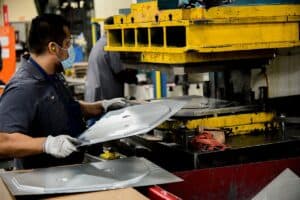It can be true in any industry, the more complex the component, the more expensive the price. We find this to be the case in metal forming parts including stamping and sheet metal fabrication. Often a part is designed with unnecessary dimensions and tolerance.
 Next, we find GD&T (Geometric Dimensioning & Tolerance) the larger challenge. Applying tolerance outside of the maximum possible tolerance within the bounds of part function can lead to higher costs as well as a non-repeatable process.
Furthermore, tolerance within the standards should be reviewed for fit, form and function. Proper tolerance can improve the timeline in prototyping and developing. The right tolerance can improve prototyping by minimizing the “back and forth” in the review and possibly speeding up the time to market. This allows sample parts to be used to more clearly see how tolerance can be applied.
Next, we find GD&T (Geometric Dimensioning & Tolerance) the larger challenge. Applying tolerance outside of the maximum possible tolerance within the bounds of part function can lead to higher costs as well as a non-repeatable process.
Furthermore, tolerance within the standards should be reviewed for fit, form and function. Proper tolerance can improve the timeline in prototyping and developing. The right tolerance can improve prototyping by minimizing the “back and forth” in the review and possibly speeding up the time to market. This allows sample parts to be used to more clearly see how tolerance can be applied.
WHERE THE CHALLENGE STARTS
We find the tolerance challenge starts with the choice of material. Steel, copper, stainless and aluminum in coil or sheet are available with a standard material thickness tolerance. A custom thickness can be manufactured with minimum purchase quantities. The custom material will drive the price upward, as well as make beginning and end difficult when only minimum quantities are required for builds. Additionally, building tooling to accommodate tight material thickness tolerance can drive tool costs. Next, we find GD&T (Geometric Dimensioning & Tolerance) the larger challenge. Applying tolerance outside of the maximum possible tolerance within the bounds of part function can lead to higher costs as well as a non-repeatable process.
Furthermore, tolerance within the standards should be reviewed for fit, form and function. Proper tolerance can improve the timeline in prototyping and developing. The right tolerance can improve prototyping by minimizing the “back and forth” in the review and possibly speeding up the time to market. This allows sample parts to be used to more clearly see how tolerance can be applied.
Next, we find GD&T (Geometric Dimensioning & Tolerance) the larger challenge. Applying tolerance outside of the maximum possible tolerance within the bounds of part function can lead to higher costs as well as a non-repeatable process.
Furthermore, tolerance within the standards should be reviewed for fit, form and function. Proper tolerance can improve the timeline in prototyping and developing. The right tolerance can improve prototyping by minimizing the “back and forth” in the review and possibly speeding up the time to market. This allows sample parts to be used to more clearly see how tolerance can be applied.

